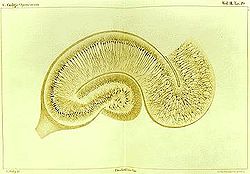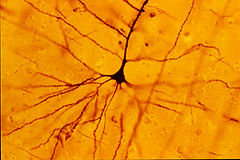
Golgi's method
Encyclopedia



Nervous tissue
Nervous tissue is one of four major classes of vertebrate tissue.Nervous tissue is the main component of the nervous system - the brain, spinal cord, and nerves-which regulates and controls body functions...
staining technique discovered by Italian
Italy
Italy , officially the Italian Republic languages]] under the European Charter for Regional or Minority Languages. In each of these, Italy's official name is as follows:;;;;;;;;), is a unitary parliamentary republic in South-Central Europe. To the north it borders France, Switzerland, Austria and...
physician
Physician
A physician is a health care provider who practices the profession of medicine, which is concerned with promoting, maintaining or restoring human health through the study, diagnosis, and treatment of disease, injury and other physical and mental impairments...
and scientist
Scientist
A scientist in a broad sense is one engaging in a systematic activity to acquire knowledge. In a more restricted sense, a scientist is an individual who uses the scientific method. The person may be an expert in one or more areas of science. This article focuses on the more restricted use of the word...
Camillo Golgi
Camillo Golgi
Camillo Golgi was an Italian physician, pathologist, scientist, and Nobel laureate.-Biography:Camillo Golgi was born in the village of Corteno, Lombardy, then part of the Austrian Empire. The village is now named Corteno Golgi in his honour. His father was a physician and district medical officer...
(1843–1926) in 1873. It was initially named the black reaction (la reazione nera) by Golgi, but it became better known as the Golgi stain or later, Golgi method.
Golgi' staining was famously used by Spanish
Spain
Spain , officially the Kingdom of Spain languages]] under the European Charter for Regional or Minority Languages. In each of these, Spain's official name is as follows:;;;;;;), is a country and member state of the European Union located in southwestern Europe on the Iberian Peninsula...
neuroanatomist Santiago Ramón y Cajal
Santiago Ramón y Cajal
Santiago Ramón y Cajal ForMemRS was a Spanish pathologist, histologist, neuroscientist, and Nobel laureate. His pioneering investigations of the microscopic structure of the brain were original: he is considered by many to be the father of modern neuroscience...
(1852–1934) to discover a number of novel facts about the organization of the nervous system, inspiring the birth of the neuron doctrine
Neuron doctrine
The neuron doctrine is a descriptive term for the fundamental concept that the nervous system is made up of discrete individual cells, a discovery due to decisive neuro-anatomical work of Santiago Ramon y Cajal and later presented, among others, by H. Waldeyer-Hartz...
. Ultimately, Ramon y Cajal improved the technique by using a method he termed "double impregnation." Ramon y Cajal's staining technique, still in use, is called Cajal's Stain.
Mechanism
The cells in nervous tissue are densely packed and little information on their structures and interconnections can be obtained if all the cells are stained. Furthermore, the thin filamentary extensions of neural cells, including the axonAxon
An axon is a long, slender projection of a nerve cell, or neuron, that conducts electrical impulses away from the neuron's cell body or soma....
and the dendrite
Dendrite
Dendrites are the branched projections of a neuron that act to conduct the electrochemical stimulation received from other neural cells to the cell body, or soma, of the neuron from which the dendrites project...
s of neurons, are too slender and transparent to be seen with normal staining techniques. Golgi's method stains a limited number of cells at random in their entirety. The mechanism by which this happens is still largely unknown. Dendrites, as well as the cell soma, are clearly stained in brown and black and can be followed in their entire length, which allowed neuroanatomists to track connections between neurons and to make visible the complex networking structure of many parts of the brain
Brain
The brain is the center of the nervous system in all vertebrate and most invertebrate animals—only a few primitive invertebrates such as sponges, jellyfish, sea squirts and starfishes do not have one. It is located in the head, usually close to primary sensory apparatus such as vision, hearing,...
and spinal cord
Spinal cord
The spinal cord is a long, thin, tubular bundle of nervous tissue and support cells that extends from the brain . The brain and spinal cord together make up the central nervous system...
.
Golgi's staining is achieved by impregnating fixed nervous tissue with potassium dichromate and silver nitrate
Silver nitrate
Silver nitrate is an inorganic compound with chemical formula . This compound is a versatile precursor to many other silver compounds, such as those used in photography. It is far less sensitive to light than the halides...
. Cells thus stained are filled by microcrystallization
Crystallization
Crystallization is the process of formation of solid crystals precipitating from a solution, melt or more rarely deposited directly from a gas. Crystallization is also a chemical solid–liquid separation technique, in which mass transfer of a solute from the liquid solution to a pure solid...
of silver chromate
Silver chromate
Silver chromate is a brown-red monoclinic crystal and is a chemical precursor to modern photography. It can be formed by combining silver nitrate and potassium chromate...
.
Technique
According to SynapseWeb, this is the recipe for Golgi's staining technique:- Immerse a block (approx. 10x5 mm) of formolFormaldehydeFormaldehyde is an organic compound with the formula CH2O. It is the simplest aldehyde, hence its systematic name methanal.Formaldehyde is a colorless gas with a characteristic pungent odor. It is an important precursor to many other chemical compounds, especially for polymers...
-fixed (or paraformaldehydeParaformaldehydeParaformaldehyde is the smallest polyoxymethylene, it is the condensation reaction product of formaldehyde with a typical degree of polymerization of 8–100 units. Paraformaldehyde commonly has a slight odor of formaldehyde due to decomposition...
- glutaraldehydeGlutaraldehydeGlutaraldehyde is an organic compound with the formula CH22. A pungent colorless oily liquid, glutaraldehyde is used to disinfect medical and dental equipment...
-perfused) brain tissue into a 2% aqueous solution of potassium dichromate for 2 days - Dry the block shortly with filter paperFilter paperFilter paper is a semi-permeable paper barrier placed perpendicular to a liquid or air flow. It is used to separate fine solids from liquids or air.-Properties:Filter paper comes in various porosities and grades depending on the applications it is meant for...
. - Immerse the block into a 2% aqueous solution of silver nitrateSilver nitrateSilver nitrate is an inorganic compound with chemical formula . This compound is a versatile precursor to many other silver compounds, such as those used in photography. It is far less sensitive to light than the halides...
for another 2 days. - Cut sections approx. 20-100 µm thick.
- Dehydrate quickly in ethanolEthanolEthanol, also called ethyl alcohol, pure alcohol, grain alcohol, or drinking alcohol, is a volatile, flammable, colorless liquid. It is a psychoactive drug and one of the oldest recreational drugs. Best known as the type of alcohol found in alcoholic beverages, it is also used in thermometers, as a...
, clear and mount (e.g., into Depex or Enthalan).
This technique has since been refined to substitute the silver precipitate with gold by immersing the sample in gold chloride then oxalic acid
Oxalic acid
Oxalic acid is an organic compound with the formula H2C2O4. This colourless solid is a dicarboxylic acid. In terms of acid strength, it is about 3,000 times stronger than acetic acid. Oxalic acid is a reducing agent and its conjugate base, known as oxalate , is a chelating agent for metal cations...
, followed by removal of the silver by sodium thiosulphate. This preserves a greater degree of fine structure with the ultrastructural details marked by small particles of gold. http://www.springerlink.com/(f0cb2ybwsglgtnuip5efub55)/app/home/contribution.asp?referrer=parent&backto=issue,5,11;journal,215,243;linkingpublicationresults,1:100182,1
Quote
Ramón y Cajal said of the Golgi method:- I expressed the surprise which I experienced upon seeing with my own eyes the wonderful revelatory powers of the chrome-silver reaction and the absence of any excitement in the scientific world aroused by its discovery.
- Recuerdos de mi vida, Vol. 2, Historia de mi labor científica. Madrid: Moya, 1917, p. 76.
External links
- Photomicrograph of a cortex cell stained with Golgi's. IHC Image Gallery.
- Golgi impregnations. Images of the brain of flies.
- Visualization of dendritic spines using Golgi Method. SynapseWeb. Includes a time-lapse study of Golgi impregnation.
- Berrebi, Albert: Cell Biology of Neurons: Structure and Methods of Study. (in PDF)

